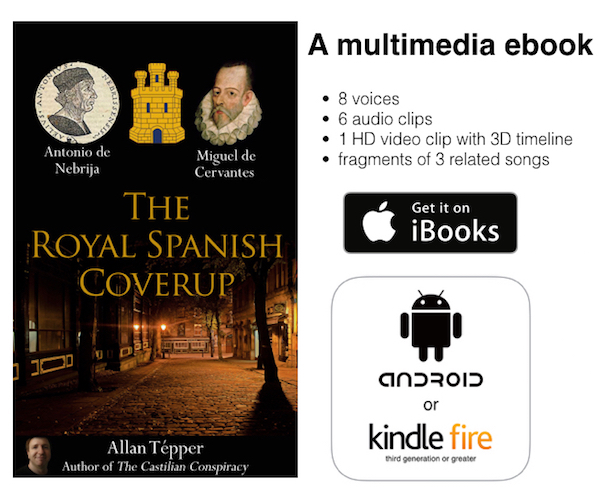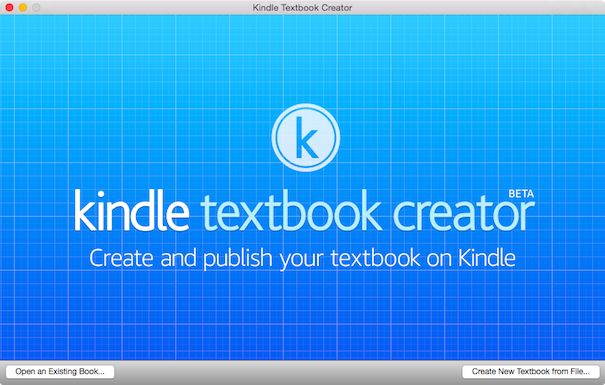In August of 2015, I published my first review of Amazon’s free Kindle Textbook Creator (KTC) program to create multimedia ebooks. Back then, I compared KTC with Apple’s iBooks Author, and explained why I preferred KTC at that time. Since then, Amazon has improved KTC slightly. It took a while, but I have finally published my first multimedia books with embedded audio and HD video. In the end, I had to use both Amazon’s KTC & Apple’s iBooks Author to reach all mobile devices due to a misleading statement in KTC’s documentation. In this article, I’ll cover the basic workflow and tools I used, the complications (and solutions) of dual distribution, and what I would like Amazon to improve further.

In August of 2015, I published my first review of Amazon’s free Kindle Textbook Creator (KTC) program to create multimedia ebooks. Back then, I compared KTC with Apple’s iBooks Author, and explained why I preferred KTC at that time. Since then, Amazon has improved KTC slightly. It took a while, but I have finally published my first multimedia books with embedded audio and HD video. In the end, I had to use both Amazon’s KTC & Apple’s iBooks Author to reach all mobile devices due to a misleading statement in KTC’s documentation. In this article, I’ll cover the basic workflow and tools I used, the complications (and solutions) of dual distribution, and what I would like Amazon to improve further.
In this article…
In this article, you’ll learn:
- Improvements in KTC version 1.11
- Clarification about KTC’s current audio/video capabilities
- The increasingly inferior Kindle experience on iOS versus on Android/Kindle Fire
- Will Apple’s iBooks ever be cross-platform?
- New marketing challenges for dual-platform distribution
- Creating assets (audio/video/text) for your multimedia book
- The basic tools and programs I used to create the audio/video assets
- Upcoming webinars on audio/video multimedia ebook creation, in two languages
Link to original review article

Here is a link to my original review article Kindle Textbook Creator facilitates embedding audio/video (illustrated above).
Improvements in KTC version 1.11
If you read my original review article, you know that initially, links to web pages that may be in an original manuscript would become inactive in the multimedia Kindle book. You could make them blue (or some other color), but they wouldn’t react if you clicked or tapped them. I am glad that I was optimistic about that and included active links anyway in my manuscript of El encubrimiento de la Real Academia and in The Royal Spanish Coverup because just as I was about to start using KTC for the authoring stage of the process, there was a welcome update to version 1.11 which finally brought that addition, at least for Android devices and Kindle Fire tablets (third generation or later). The other improvement in KTC 1.11 is that it can now allow inline audio playback without the need of a popup window, also with Android and Kindle Fire tablets (third generation or later). I used that inline audio player for the foreword (prólogo) of the Castilian version of the book (by Irene Jiménez Miragaya of Audiovisual451.com), although the English version currently has her foreword as text only. Having said that, the video unfortunately still needs to be a popup in a KTC multimedia book, and we are still unable to link any self-produced graphic per se to an audio or video player. For video, the only official visual link options are currently the KTC-supplied video player symbol (a camera image which unfortunately, still cannot be resized) or a text link. For the video, I created a screen capture of KTC’s own preview player, and then I used that as a fake player graphic in the PDF I fed KTC for the most current version. Then I placed KTC’s camera video icon on top of the play button in the fake video player graphic. I really hope that Amazon will improve those things in KTC in some upcoming version.
Clarification about KTC’s current audio/video capabilities
Although all of the Kindle books created with KTC can indeed open and show the text and photos on iOS devices (iPad/iPhone/iPod Touch), even with the latest version 4.17 of the Kindle app for iOS —which was just released on February 1st, 2016, the audio and video links either don’t appear at all, or are non-functional. If you use KTC’s own audio and video link symbols, they sadly don’t appear at all on iOS devices. (Thanks to Rubén Abruña, Jorge Mezéi and Memo Sauceda for verifying that). If you use text links to the audio or video files, they appear on iOS devices, but do not react if you tap on them. Both of these limitations were later confirmed to be expected behavior by a rather confusing statement on Amazon’s KTC website. That’s why I (quite regretfully) had to cancel my 90-day exclusivity commitment to Amazon’s KDP Select, which means that I will unfortunately not count on KDP Select’s extra promotional benefits for these particular books. However, I really need my interactive ebooks to be completely useful cross-platform: both on Android (including Kindle Fire) and on iOS devices. So I did extra work to re-create the multimedia books using Apple’s iBooks Author tool, and even more to create a new website specific to each book to help readers choose and direct them to the proper store, as explained ahead in the section called New marketing challenges for dual-platform distribution.
Amazon says that some future version of the Kindle app for iOS will eventually allow for full cross platform with audio and video, but there is no ETA, and the KTC program has been available for many months. In the next section, I explain why I believe this situation is a political or economic limitation, not a technical one.
The increasingly inferior Kindle experience on iOS versus on Android/Kindle Fire
The lack of audio/video playback from interactive audio/video Kindle books is not the first time that circumstances have made the Kindle experience on iOS (iPad/iPhone/iPod Touch) inferior compared with the Kindle experience on Android/Kindle Fire. When a reader uses the Kindle app on an Android or Kindle Fire device, s/he may actually purchase new books directly from the app after browsing for them. This isn’t the case with the Kindle app on iOS, since if that were possible, Amazon would have to give Apple a very hefty commission on the in-purchase sale. That’s why Kindle app users on iOS must make the actual purchase of any new Kindle book outside of the iOS Kindle app, either via the web browser on the same iOS device, or on any web browser on a separate computer, and then send the new book to the Kindle app on the iOS device from that browser.
I have no inside information, but I am sure that Amazon’s programmers are completely capable of allowing the Kindle app on iOS to play audio and video, since at least two other Amazon iOS apps already do. (The Audible app for audiobooks already allows audio playback on iOS, and Audible Inc. belongs to Amazon since 2008. The Amazon Video app for iOS plays video for Amazon Prime members on iOS.) I suspect that there is a licensing or commission issue in play, where Apple likely wants its own iBooks ecosystem to be exclusive on iOS, or wants an additional payment. This situation is not only sad but also dangerously confusing to potential multimedia Kindle ebook purchasers, because the Amazon website says on the sales page of multimedia Kindle books that they will work with iOS. Technically speaking, multimedia Kindle books will download and open on iOS, but the audio and video links will either not appear or not be functional, as explained in the prior section. As a result, I was compelled to add a disclaimer to the book descriptions on the Amazon page to warn purchasers from purchasing the Kindle version of these multimedia books for use on an iOS device. In my humble opinion, Amazon should be the one to be putting that disclaimer for this type of multimedia Kindle book sales pages, the same way that Amazon makes it clear that these multimedia Kindle books won’t work at all with greyscale Kindle devices.
Will Apple’s iBooks ever be cross-platform?
It is quite conceivable that Apple might create an iBooks reader app for Android. If you think that’s crazy, note that Apple recently started offering its Apple Music app for Android, so Apple is certainly no longer ignoring or boycotting Android as in the past.
New marketing challenges for dual-platform distribution
With most of my traditional books (either print or ebooks, but without embedded audio or video), I have a URL with the book’s name that just points automatically to the closest Amazon store with the book’s sales page. Now with multimedia books (with audio and video embedded), it’s more complex. Because (as of publication time of this article) neither iBooks nor KTC is truly cross-platform for multimedia books, I had to create a sales landing page, with a photo, book description, and then the option to click either for the iBooks version for iOS or Mac devices, or the Kindle version for Android and Kindle Fire devices. Those then link to the appropriate sales page of the particular book for either platform. Here you can see how I did that on TheRoyalSpanishCoverup.com
and Elencubrimientodelarealacademia.com for the Castilian version (illustrated above).
Creating assets (audio/video/text) for your multimedia book
Neither iBooks Author nor KTC is really a complete creation tool, since neither is designed to record or edit audio or video. Both are really authoring tools, where you create nearly everything using your favorite other tools for audio and video production, and then combine them with these tools in the authoring stage. A major exception to that statement is that at least with iBooks Author, you could actually write the manuscript within that app, if you hadn’t already written it with another app. (I have written the text of most of my recent books, longer articles and white papers with Ulysses, and prior to that I used Scrivener, for reasons that go beyond the scope of this article.) So with the possible exception of writing the manuscript, everything else needs to be created, recorded and edited externally of these two authoring tools, in advance of the authoring stage. The basic production (recording) and editing can be the same for the iBooks or the multimedia Kindle version, although minor changes occur with some of the formats you should export for each, as you’ll see ahead.
Audio format, códec and extension
For audio, KTC only wants an MP3. There is no other specification given. Fortunately, both KTC and all modern Android phones and tablets can play 48 kHz audio, so I stuck to 48 kHz in all production and editing, and simply encoded a 48 kHz MP3 for KTC, and all was well.
On the other hand, iBooks Author specifically requests AAC (M4A). As I have covered in prior articles, AAC (M4A) is more modern and more efficient than MP3, but less compatible across multiple devices. However, considering that ebooks created with iBooks Author can only be consumed (at least currently) on iOS and Macs, the compatibility concern doesn’t exist here. iBooks Author specifies 8 to 320 Kbps, 48 kHz stereo for the AAC. I love the fact that iBooks Author wants 48 kHz, but I was disappointed that it demands stereo, since in the case of a single voice (without stereo music or any stereo effect with the voice), it is a waste of space and bandwidth when uploading and downloading. In any case, for iBooks Author I encoded AAC separately from the master of each audio-only file. iBooks Author wants the AAC audio file to have an M4A extension, and that’s exactly how I encoded them.
Asset audio and video formats, códecs and extensions
For video, KTC specifically requests MP4, and does not go into any more detail. For KTC, I encoded H.264 High Profile 720p (1280×720) 29.97p and maintained the 48 kHz audio sampling rate. All played perfectly on the multiple Android devices tested.
On the other hand, iBooks Author says a lot about the video encoding, For HD, iBooks Author requests H.264 High Profile level 4.2 with AAC-LC audio up to 160 kbps, 48 kHz (which I liked), stereo audio (which concerned me, since in many cases it would be a waste of bandwidth and space, as indicated earlier), but only specifically mentions which extensions not to use for video. The Apple website says: “You can’t use media that has .m4v or .m4p file extensions.” So for example, you can use an MP4 video file (like the one I encoded for KTC) or an MOV encoded as indicated. With iBooks Author, it’s best to create your audio and video exactly as the program requests it to avoid re-encoding within the iBooks Author program, since that would be both time-consuming and reduce the final quality.
The basic tools and programs I used to create and edit the audio/video assets
I recorded the sound of my own voice using the Audio Technica BP40 microphone (reviewed here)
via the SoundDevices MixPre-D mixer/preamp/A-to-D converter (reviewed here).
I used Telestream’s Screenflow for video recording and editing.
I used Hindenburg Journalist Pro for audio recording and editing. (I reviewed Hindenburg’s audio tools here, here, and here.)
While editing, I used ATH-M70x headphones, the most comfortable ones I’ve ever worn to date.
Upcoming webinars on audio/video multimedia ebook creation, in two languages
In this upcoming live webinar, I’ll cover all of the minutia of the workflow of my recent multimedia books, including a live questions and answers session. I will actually be doing the same webinar in two different languages, one in English and the other in Castilian (castellano), aka “Spanish” (“español”). Be sure to be on my mailing list for details.
Upcoming articles, reviews, and books
Stand by for upcoming articles, reviews, and books. Sign up to my free mailing list by clicking here.
Si deseas suscribirte a mi lista en castellano, visita aquí. Si prefieres, puedes suscribirte a ambas listas (castellano e inglés).
Books, consulting, articles, seminars & radio programs
Contact Allan Tépper for consulting, or find a full listing of his books, articles and upcoming seminars and webinars at AllanTepper.com. Listen to his CapicúaFM program at CapicúaFM.com in iTunes or Stitcher.
FTC disclosure
No manufacturer is specifically paying Allan Tépper or TecnoTur LLC to write this article or the mentioned books. Some of the other manufacturers listed above have contracted Tépper and/or TecnoTur LLC to carry out consulting and/or translations/localizations/transcreations. Many of the manufacturers listed above have sent Allan Tépper review units. So far, none of the manufacturers listed above is/are sponsors of the TecnoTur programs, although they are welcome to do so, and some are, may be (or may have been) sponsors of ProVideo Coalition magazine. Some links to third parties listed in this article and/or on this web page may indirectly benefit TecnoTur LLC via affiliate programs.
Copyright and use of this article
The articles contained in the TecnoTur channel in ProVideo Coalition magazine are copyright Allan Tépper/TecnoTur LLC, except where otherwise attributed. Unauthorized use is prohibited without prior approval, except for short quotes which link back to this page, which are encouraged!


